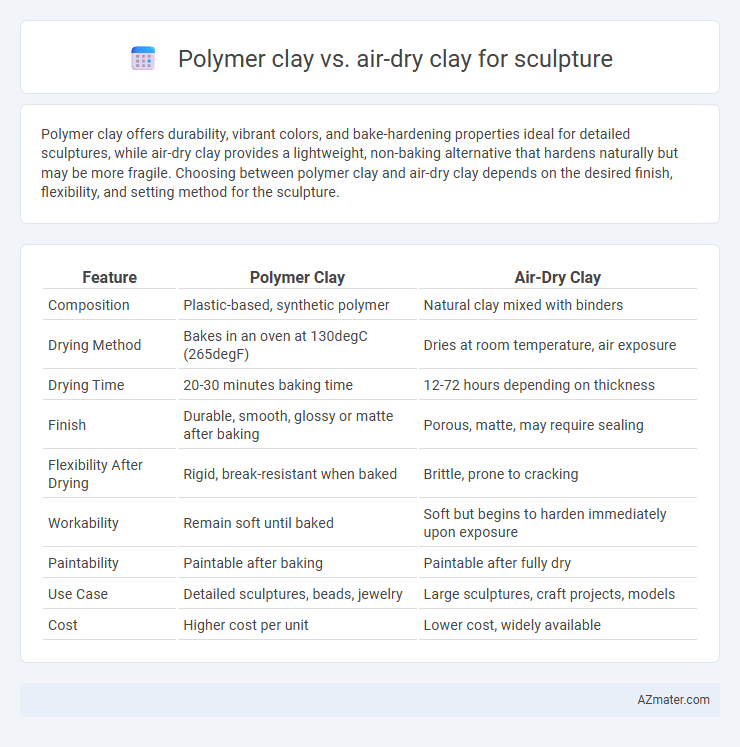Polymer clay offers durability, vibrant colors, and bake-hardening properties ideal for detailed sculptures, while air-dry clay provides a lightweight, non-baking alternative that hardens naturally but may be more fragile. Choosing between polymer clay and air-dry clay depends on the desired finish, flexibility, and setting method for the sculpture.
Table of Comparison
| Feature | Polymer Clay | Air-Dry Clay |
|---|---|---|
| Composition | Plastic-based, synthetic polymer | Natural clay mixed with binders |
| Drying Method | Bakes in an oven at 130degC (265degF) | Dries at room temperature, air exposure |
| Drying Time | 20-30 minutes baking time | 12-72 hours depending on thickness |
| Finish | Durable, smooth, glossy or matte after baking | Porous, matte, may require sealing |
| Flexibility After Drying | Rigid, break-resistant when baked | Brittle, prone to cracking |
| Workability | Remain soft until baked | Soft but begins to harden immediately upon exposure |
| Paintability | Paintable after baking | Paintable after fully dry |
| Use Case | Detailed sculptures, beads, jewelry | Large sculptures, craft projects, models |
| Cost | Higher cost per unit | Lower cost, widely available |
Introduction to Polymer Clay and Air-Dry Clay
Polymer clay is a durable, synthetic modeling material that hardens when baked in an oven, offering vibrant colors and fine detail retention ideal for intricate sculptures. Air-dry clay is a natural, water-based medium that hardens by exposure to air without baking, providing a lightweight and easily accessible option suitable for larger or less detailed projects. Both clays serve distinct purposes in sculpture, with polymer clay favored for precision and longevity, and air-dry clay prized for convenience and ease of use.
Material Composition and Properties
Polymer clay is composed mainly of polyvinyl chloride (PVC) combined with plasticizers, giving it a durable, flexible structure that hardens permanently when baked at low temperatures, typically around 130degC (266degF). Air-dry clay consists primarily of natural materials such as cellulose fibers, water, and binders, curing through moisture evaporation at room temperature to create a porous, lightweight, and less durable finish. Polymer clay offers a non-porous surface ideal for detailed sculpting and painting, whereas air-dry clay is valued for its ease of use and eco-friendly, biodegradable properties.
Ease of Use and Sculpting Techniques
Polymer clay offers superior ease of use due to its pliability and ability to be baked in a home oven, allowing for detailed sculpting techniques like fine texturing and layering. Air-dry clay requires patience as it hardens by exposure to air, limiting working time but enabling simple techniques like hand modeling and carving once dry. For intricate designs and extended working periods, polymer clay provides more flexibility, while air-dry clay excels in quick, straightforward projects with natural drying.
Drying and Curing Processes
Polymer clay cures through baking in an oven at temperatures around 265degF to 275degF (129degC to 135degC), allowing it to harden completely within 15 to 30 minutes depending on thickness. Air-dry clay sets by exposure to room temperature and air moisture, typically drying within 24 to 72 hours, but may require longer drying times for thicker sculptures to avoid cracking. Unlike polymer clay's permanent oven curing, air-dry clay hardens naturally and remains porous, affecting durability and finish quality.
Strength and Durability
Polymer clay offers superior strength and durability due to its capacity to be oven-baked, creating a tough, resilient finish ideal for long-lasting sculptures. Air-dry clay, while convenient and easy to use, tends to be more fragile and can crack or crumble over time, especially in humid environments. For sculptures requiring enhanced structural integrity and longevity, polymer clay is the optimal choice.
Surface Finish and Paintability
Polymer clay offers a smooth, non-porous surface finish ideal for detailed sculptures and holds paint exceptionally well without requiring a primer, allowing for vibrant and long-lasting colors. Air-dry clay typically has a more porous and slightly rougher surface, which can absorb paint unevenly and often benefits from sealing to achieve a uniform finish. Artists often prefer polymer clay for projects demanding precise surface detail and consistent paint adhesion, while air-dry clay suits larger, less detailed sculptures where texture enhances the artwork.
Flexibility for Detailing and Texturing
Polymer clay offers superior flexibility for detailing and texturing in sculpture due to its pliable nature before curing, allowing artists to create intricate designs and fine textures without cracking. Air-dry clay tends to harden quickly, limiting its workability and the ability to refine details over extended periods, which can affect the precision of textures. The elasticity of polymer clay during manipulation makes it ideal for complex, detailed projects requiring meticulous surface work.
Safety and Non-Toxicity Considerations
Polymer clay is generally considered safe when used as directed, but it may release harmful fumes if overheated, requiring proper ventilation during baking. Air-dry clay is non-toxic and free from harmful chemicals, making it a safer option for children and indoor use without the need for baking. Both clays should be handled according to manufacturer guidelines to avoid allergic reactions or skin irritation.
Cost and Accessibility
Polymer clay typically costs between $10 to $30 per pound and is widely accessible in craft stores and online retailers, making it a convenient option for sculptors. Air-dry clay is generally more affordable, often priced around $5 to $15 per pound, and is available at most art supply shops, home improvement stores, and even supermarkets. Both materials offer easy access, but air-dry clay's lower price point makes it a budget-friendly choice for large or frequent projects.
Best Uses for Sculpture Projects
Polymer clay offers exceptional detail and durability, making it ideal for intricate sculptures, jewelry, and small figurines that require baking for hardening. Air-dry clay is best suited for larger, lightweight projects and quick prototypes, as it hardens by drying naturally without the need for an oven. Artists often choose polymer clay for fine textures and vibrant colors, while air-dry clay excels in easy cleanup and flexible drying times for diverse sculpting techniques.

Infographic: Polymer clay vs Air-dry clay for Sculpture
 azmater.com
azmater.com